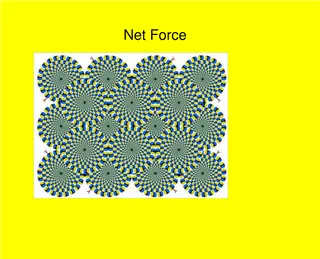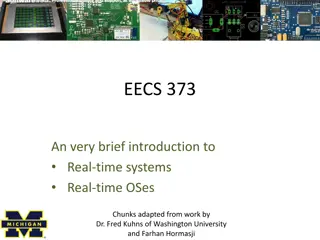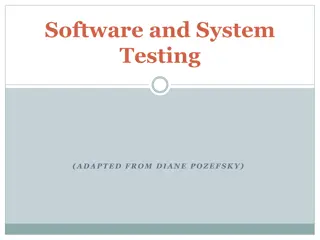Supercharge Your .NET Testing with NCrunch Real-Time, Continuous, and Parallel Testing
NCrunch is a cutting-edge tool for .NET testing that revolutionizes the testing process. Say goodbye to slow feedback loops and manual interruptions - NCrunch runs tests in the background as you code, providing instant feedback and real-time code coverage. With features like continuous test execution, parallel execution, and code coverage visualization, NCrunch enhances your development workflow and improves code quality. It seamlessly integrates with Visual Studio and JetBrains Rider, making testing effortless and insightful. Download NCrunch now and experience a new level of efficiency in your projects!
Download Presentation

Please find below an Image/Link to download the presentation.
The content on the website is provided AS IS for your information and personal use only. It may not be sold, licensed, or shared on other websites without obtaining consent from the author.If you encounter any issues during the download, it is possible that the publisher has removed the file from their server.
You are allowed to download the files provided on this website for personal or commercial use, subject to the condition that they are used lawfully. All files are the property of their respective owners.
The content on the website is provided AS IS for your information and personal use only. It may not be sold, licensed, or shared on other websites without obtaining consent from the author.
E N D
Presentation Transcript
Exploring Energy-Latency Tradeoffs for Broadcasts in Energy-Saving Sensor Networks AUTHOR: PRESENTER: MATTHEW J. MILLER WENYU REN CIGDEM SENGUL INDRANIL GUPTA 1
Wireless Sensor Networks (WSNs) Resources Energy CPU Memory Performance Latency Reliability vs. 2
Sensor Application Type 1 Code Update Application Updates Generated Once Every Few Weeks Here is Patch #27 Reducing energy consumption is important Latency is not a major concern 3
Sensor Application Type 2 Short-Term Event Detection E.g., Intruder Alert for Temporary Overnight Camp Look For An Event With These Attributes Latency is critical With adequate power supplies, energy usage is not a concern 4
Energy-Latency Relationship Energy Latency 5
Broadcast in Sensor Networks Flooding: a high number of redundant packets SPIN: incorporate negotiation Virtual Infrastructure Gossip 6
Sleep Scheduling Mechanism Active-sleep Cycle Divide time into frames Active time: send and receive messages Sleep time: radio in sleep mode to save energy Examples IEEE 802.11 Power Save Mode (PSM) S-MAC/T-MAC 7
N1 N2 N3 Broadcast in IEEE 802.11 PSM BI BI A D N1 D A N2 A D N3 A = ATIM Pkt AW ATIM window D = Data Pkt 8
N1 N2 N3 Extreme 1 (PSM) BI BI A D N1 D A N2 A N3 A = ATIM Pkt D = Data Pkt 9
N1 N2 N3 Extreme 2 BI BI A D N1 D N2 D N3 A = ATIM Pkt D = Data Pkt 10
Probability-Based Broadcast Forwarding (PBBF) Goal with high probability, a node receives at least one copy of each broadcast packet, while reducing the latency due to sleeping Two parameters: p and q p the probability that a node rebroadcasts a packet in the current active time despite the fact that not all neighbors may be awake to receive the broadcast q the probability that a node remains on after the active time when it normally would sleep 11
N1 N2 N3 PBBF Example w/ Pr=q w/ Pr=p ID N1 w/ Pr=p w/ Pr=(1-q) ID N2 w/ Pr=q w/ Pr=(1-p) A D N3 ID = Immediate Broadcast A = ATIM Pkt D = Normal Broadcast 12
PBBF Characteristics p = 0 and q = 0: The original sleep scheduling protocol p = 1 and q = 1: Approximation of the always-on mode p: latency vs. reliability q: energy vs. reliability Effects of p and q on energy, latency and reliability: Energy Latency Reliability p --- if q > 0 if p > 0 if q < 1 if p > 0 q 13
Analytical Results: Reliability Bond (edge) percolation model pedge: probability that an edge between two vertices is open ?????> ????????? Phase 0 Phase 1 ?????< ????????? 14
Analytical Results: Reliability The probability that a broadcast is received on a link A B is: pedge = pq + (1-p) Immediate broadcast of A B being awake Rebroadcast when B is awake pq + (1-p) > pcritical every broadcast reaches most of the nodes in the network 15
Analytical Results: Reliability Received by 99% of Nodes Fraction of Broadcasts q 16
Analytical Results: Energy active T + = E original active T sleep T sleep T E =1 + q PBBF E active T original 17
Analytical Results: Latency L: the expected time between A sending the broadcast and B receiving it from A L1: time to immediately transmit the data packet L2: time to wake up all neighbors for the broadcast ( ) ( ) p ) + + 1 L p q L + 1 L 1 p = L 1 1 2 ( p q p = + L L 1 2 + 1 p p q LS,B: the latency from the source S to the node B len(S, B): average length (in terms of hop count) of the path from S to B ( ) = L L len S B , S B , 18
Analytical Results: Latency Increasing p 19
Analytical Results: Latency Flooding Hop Count Average 60-Hop Increasing Reliability q 20
sleep T E =1 + q PBBF E active T original Analytical Results: Energy-Latency Tradeoff 1- p L = L1+L2 1- p+ p q sleep T + L L L 1 p = E 1 E 2 1 PBBF original L L p active T 1 Set the values of p and q so that they are just across the reliability threshold boundary and into the high reliability region Tune these values (staying close to the boundary) until the desired energy-latency trade-off is achieved Achievable region for reliability Joules/Broadcast 99% Average Per-Hop Broadcast Latency (s) 21
Simulation Results Simulated code distribution application in ns-2 network simulator Parameter N PTX PI PS Value 50 81 mW 30 mW 3 W Parameter Tframe Tactive q Total Packet Size Data Packet Payload Value 10 s 1 s 0.25 10.0 0.01 packets/s 64 bytes L1 30 bytes 1.5 s 22
Simulation Results: Energy Energy sleep T E =1 + q PBBF Joules/Broadcast E active T original q 23
Simulation Results: Latency Latency Average 5-Hop Latency Increasing p q 24
Simulation Results: Reliability Broadcasts Received Average Fraction of q 25
Conclusion Have presented, analyzed, simulated, and measured the performance of a class of probabilistic broadcast protocols for multi-hop WSNs. Have quantified the energy-latency trade-off required to obtain a given level of reliability using PBBF. Have implemented the PBBF protocols in ns-2 and have studied the performance characteristics of PBBF when used for code distribution. Experiments indicate that PBBF is an efficient broadcast mechanism in the sense that it provides an application designer the opportunity to tune the system to an appropriate operating point along the reliability resource-performance spectrum. 26
Discussion Pros: PBBF can be used in conjunction with any sleep scheduling protocol Provides theoretical explanation as well as simulation results Cons: Perfect synchronization assumption is not valid No real deployment of PBBF 27
Thank You 28























